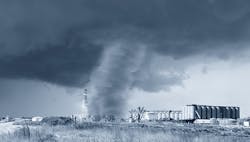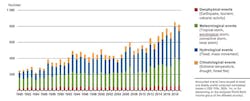Disaster Planning: Improve Your Plant’s Resilience
Chemical makers must boost their resiliency — that is, their ability to withstand, recover from and continue to prosper in the face of an increasing number of natural and man-made disasters. Natural disasters, including those due to climate change, come in both acute and chronic forms. Acute shocks are storms, hurricanes, tornados, earthquakes and floods, while chronic stresses are longer-term impacts such as droughts or rising sea levels.
The increasing trend of natural disasters since 1980 is irrefutable. Figure 1, developed by Munich Reinsurance America, New York City, clearly shows this. That company noted 2020 was a record hurricane season, with more storms in the North Atlantic than ever previously recorded. Worldwide disasters accounted for losses of $210 billion, with only 39% covered by insurance. The United States incurred 45% of these losses.
The United Nations Office for Disaster Risk Reduction (UNDRR), Geneva, Switz., reported that 7,348 disasters took place from 2000 to 2019, a 74% increase over the previous 20 years. Financial losses during 2000–2019 approached $3 trillion! Moreover, the global trend of population migration to major metropolitan areas puts more people at risk to the impact of disasters.
To counter this trend, chemical manufacturers must consider adaptive actions to reduce risks today and prepare for further changes in the future as well as mitigative moves to address the root causes of climate change (e.g., atmospheric greenhouse gases and current industrial emissions) to secure long-term solutions. This article highlights steps a company may take to reduce its risks from climate change and resulting disasters — with an emphasis on adaptation.
Improving resilience by implementing adaptive actions to climate change should be a strategic priority. Facilities operating in high-risk locations may become undisclosed liabilities to shareholders, with significant potential impact on financial performance. This also is true of members of the supply chain that provide essential supplies and services.
Figure 1. The number of natural disasters has been growing over recent decades. Source: Munich Re.
The Financial Stability Board, Basel, Switz., an international body that looks at global financial vulnerabilities, set up a taskforce in 2015 to develop voluntary, consistent climate-related-risk disclosures for use by corporations. That taskforce in 2017 outlined a framework for reporting climate-related financial information. In 2010, the U.S. Securities and Exchange Commission (SEC), Washington, D.C, published guidance for public companies to disclose the impact of climate change on their business and the costs of complying with climate-related laws. There is speculation the Biden Administration will do more to have companies disclose potential liabilities from climate-related events.
Developing a Strategy
When assessing how to prepare for, respond to and recover from disaster events, a company should factor in ten general considerations:
1. Risk evaluation is a natural part of capital investment decisions. However, assessments often don’t consider climate-related risks from acute shocks or chronic stresses. Threats are unique to each location and plant configuration. To manage risk effectively and build sustained resilience requires an understanding of risk/reward trade-offs. Unless investment decisions become more “risk informed,” we will continue to experience increasing loss of life and capital assets.
2. The intensity and frequency of climate-related disaster events is growing globally, as Figure 1 highlights. There’s no shortage of evidence of North America suffering from more fires due to drought conditions and increasing damage from more-intense severe weather incidents such as tornados, hurricanes, floods and extreme temperatures (most recently experienced in Texas).
3. A company should consider the risk of such disasters not just in its investment decisions but also in the planning, development, design, siting and building of plant infrastructure — for instance, by avoiding construction in high-risk areas where adaptation is extremely expensive or not even possible.
4. An investment in disaster risk reduction through structural and non-structural measures is essential to enhance the economic, social, health and cultural resilience of a company as well as to protect the environment. If targeted correctly, risk-informed investments will reward an organization with continuity of business operations, leading to better financial performance over the long term — pleasing shareholders and attracting investors.
5. With so much competition for investment dollars, creating a compelling case to invest capital today for an event that “may” happen tomorrow will remain challenging. A company should recognize this funding dilemma.
6. There are pockets of innovative breakthrough investments but much more must be done. The public sector can increase private sector incentives for resilient investments for both retrofitting as well as for siting and design of new plants.
Programs such as no-interest loans or tax incentives are needed. “Resilience” or “green” bonds to finance risk-reducing interventions should become important funding sources.
7. Work remains to create the right enabling environment for risk-informed, risk-reducing investments. For good reason much disaster-risk-reduction work focuses on vulnerable environments (e.g., coastlines) but extreme weather events aren’t limited to those areas. Flash floods, chronic droughts, extreme temperatures and wildfires occur across continents. Here, visionary private sector companies are leading the way.
8. A systematic application of technology will deliver faster improvements. There’s a need for early warning systems and resilience analytics. In addition, regulators must update and enforce building codes. Lessons learned must be effectively shared locally, regionally, nationally and globally. Many tools and resources available today, like the UNDRR “Disaster Resilience Scorecard for the Owners and Operators of Industrial and Commercial Buildings,” deserve wider use to identify priority needs to improve resilience.
9. A broad range of technical resources are needed to holistically evaluate climate-related risks and ensure siting and design are resilient to local threats.
10. The UNDRR’s Sendai Framework 2015–2030 for Disaster Risk Reduction does embrace participation by the private sector but now we must operationalize this intent. We must strengthen risk governance to sharpen the measurement and articulation of resilience, track improvements over time, accelerate public/private collaboration, and share lessons learned. These efforts will help reduce losses and the impact of disasters on people, governments and economies to achieve the goals of the Sendai Framework.
Planning and Adapting In Advance
In 2020, the UNDRR’s private-sector advisory group known as ARISE released the “Disaster Resilience Scorecard for the Owners and Operators of Industrial and Commercial Buildings.” This tool suits both single- and multi-building facilities. It provides a way for owners and managers to baseline the resilience of their buildings to climate-related disasters and, thus, to prioritize resilience improvements. This scorecard is based upon what UNDRR considers the ten essentials for disaster risk reduction (Figure 2). The scorecard comes in two versions: a screening assessment tool and a more-granular assessment tool with more than 100 indicators to score in a self-assessment process. You can access the scorecard here.
Figure 2. The United Nations Office for Disaster Risk Reduction bases its resilience scorecard on these elements. Source: UNDRR.
The scorecard enables you to better understand your climate-related-disaster risk-reduction position by looking at a variety of factors and issues (Table 1). It involves ten steps:
- Review the existing organizational structure: Is a plan in place? Are staff trained?
- Check available data to define the risks your location faces: hurricanes, tornados, catastrophic floods, droughts, storms of major proportions, etc. What about the potential for earthquakes or extreme temperature events as occurred recently in Texas? To become resilient, you must define the type and magnitude of threats that might impact your plant.
- Evaluate access to capital to prepare for and facilitate recovery from a disaster event. Are contractors and equipment available to provide needed services and products?
- Integrate resilience planning with capital investment. Will this capital expenditure improve resilience? Will the investment face climate-related risks?
- Consider the existing inventory of green infrastructure (rain gardens, green roofs, high-moisture-absorbing trees, etc.); these can play an important part in tempering extreme rainfall events.
- Strengthen the overall institutional capacity for resilience. These resources need not necessarily be local if they are available within the company or through contractors. For example, many plants require access to water for their operations. Too little water due to drought conditions or too much water from floods can have significant adverse impact. One example of a way to mitigate such events is, if land near the plant is available, to construct a reservoir. It then could provide water during droughts and collect water to mitigate floods.
- Strive to better connect the plant with the community to work together to improve resilience. Evacuation centers, transportation corridors and emergency response actions must interact and connect with the community at large to be successful. Plans for plant growth and expansion must consider the effect on evacuation corridors.
- Establish routine evaluations of the vulnerability of critical infrastructure. How secure is chemical storage? What about energy production units? Will they continue to operate in extreme conditions? What if power lines go down or cell tower failures interrupt communications?
- Take actions necessary to ensure the availability of effective disaster response capabilities, including the operation of communication systems and access to healthcare facilities. Are the emergency plans updated and reviewed at least quarterly? Are emergency drills performed to prepare for disaster events?
- Develop and implement plans to expedite recovery and build back better. Part of this step is to make certain that early warning systems are in place and plant personnel are trained to respond.
Make Resilience An Imperative
The journey to improve plant resilience is a multi-step process that requires commitment, careful analysis and corporate support. Resources always are limited, so getting funds to prepare and protect against what “could” happen can pose challenges. However, it’s essential to establish a proper balance that enables taking adaptive actions consistently and in a measured way to improve survivability of assets and protect personnel and the community at large.
The chemical industry must address climate-related risks. Indeed, resilience improvement should factor into all capital expenditures. Adaptation is the first but not only priority. While we certainly must deal with current risks, we also must take steps to mitigate the emissions of greenhouse gases and other factors that contribute to climate change. These are inter-related priorities.
DALE SANDS is principal of MS Sands Consulting Solutions, Byron, Mich., and former co-chair of ARISE, a private sector advisory group to the UN Office of Disaster Risk Reduction. Email him at [email protected].


